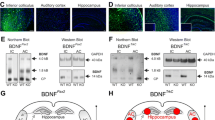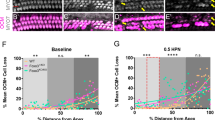Abstract
A correlation between noise-induced apoptosis and cell loss has previously been shown after a single noise exposure in the cochlear nucleus, inferior colliculus, medial geniculate body (MGB) and primary auditory cortex (AI). However, repeated noise exposure is the most common situation in humans and a major risk factor for the induction of noise-induced hearing loss (NIHL). The present investigation measured cell death pathways using terminal deoxynucleotidyl transferase dUTP nick end labeling (TUNEL) in the dorsal, medial and ventral MGB (dMGB, mMGB and vMGB) and six layers of the AI (AI-1 to AI-6) in mice (NMRI strain) after a second noise exposure (double-exposure group). Therefore, a single noise exposure group has been investigated 7 (7-day-group-single) or 14 days (14-day-group-single) after noise exposure (3 h, 5–20 kHz, 115 dB SPL peak-to-peak). The double-exposure group received the same noise trauma for a second time 7 days after the initial exposure and was either TUNEL-stained immediately (7-day-group-double) or 1 week later (14-day-group-double) and data were compared to the corresponding single-trauma group as well as to an unexposed control group. It was shown that TUNEL increased immediately after the second noise exposure in AI-3 and stayed upregulated in the 14-day-group-double. A significant increase in TUNEL was also seen in the 14-day-group-double in vMGB, mMGB and AI-1. The present results show for the first time the influence of a repeated noise trauma on cell death mechanisms in thalamic and cortical structures and might contribute to the understanding of pathophysiological findings and psychoacoustic phenomena accompanying NIHL.






Similar content being viewed by others
References
Aarnisalo AA, Pirvola U, Liang XQ, Miller J, Ylikoski J (2000) Apoptosis in auditory brainstem neurons after a severe noise trauma of the organ of Corti: intracochlear GDNF treatment reduces the number of apoptotic cells. ORL J Otorhinolaryngol Relat Spec 62:330–334
Ahroon WA, Hamernik RP (2000) The effects of interrupted noise exposures on the noise-damaged cochlea. Hear Res 143:103–109
Alvarado JC, Fuentes-Santamaria V, Gabaldon-Ull MC, Jareno-Flores T, Miller JM, Juiz JM (2016) Noise-induced “toughening” effect in Wistar rats: enhanced auditory brainstem responses are related to calretinin and nitric oxide synthase upregulation. Front Neuroanat 10:19
Basta D, Tzschentke B, Ernst A (2005) Noise-induced cell death in the mouse medial geniculate body and primary auditory cortex. Neurosci Lett 381:199–204
Bose M et al (2010) Effect of the environment on the dendritic morphology of the rat auditory cortex. Synapse 64:97–110
Calford MB (1983) The parcellation of the medial geniculate body of the cat defined by the auditory response properties of single units. J Neurosci 3:2350–2364
Calford MB, Aitkin LM (1983) Ascending projections to the medial geniculate body of the cat: evidence for multiple, parallel auditory pathways through thalamus. J Neurosci 3:2365–2380
Caspary DM, Llano DA (2017) Auditory thalamic circuits and GABAA receptor function: putative mechanisms in tinnitus pathology. Hear Res 349:197–207
Choi DW (1995) Calcium: still center-stage in hypoxic-ischemic neuronal death. Trends Neurosci 18:58–60
Coomber B, Berger JI, Kowalkowski VL, Shackleton TM, Palmer AR, Wallace MN (2014) Neural changes accompanying tinnitus following unilateral acoustic trauma in the guinea pig. Eur J Neurosci 40:2427–2441
Coordes A, Groschel M, Ernst A, Basta D (2012) Apoptotic cascades in the central auditory pathway after noise exposure. J Neurotrauma 29:1249–1254
Eggermont JJ (2017) Effects of long-term non-traumatic noise exposure on the adult central auditory system. Hearing problems without hearing loss. Hear Res 352:12–22
Eggermont JJ, Roberts LE (2004) The neuroscience of tinnitus. Trends Neurosci 27:676–682
Ehret GR, Romand R (1997) The central auditory system. Oxford University Press, Oxford
Eimerl S, Schramm M (1994) The quantity of calcium that appears to induce neuronal death. J Neurochem 62:1223–1226
Gavrieli Y, Sherman Y, Ben-Sasson SA (1992) Identification of programmed cell death in situ via specific labeling of nuclear DNA fragmentation. J Cell Biol 119:493–501
Godfrey DA, Kaltenbach JA, Chen K, Ilyas O (2013) Choline acetyltransferase activity in the hamster central auditory system and long-term effects of intense tone exposure. J Neurosci Res 91:987–996
Grasl-Kraupp B, Ruttkay-Nedecky B, Koudelka H, Bukowska K, Bursch W, Schulte-Hermann R (1995) In situ detection of fragmented DNA (TUNEL assay) fails to discriminate among apoptosis, necrosis, and autolytic cell death: a cautionary note. Hepatology 21:1465–1468
Gröschel M, Götze R, Ernst A, Basta D (2010) Differential impact of temporary and permanent noise-induced hearing loss on neuronal cell density in the mouse central auditory pathway. J Neurotrauma 27:1499–1507
Gröschel M, Müller S, Götze R, Ernst A, Basta D (2011) The possible impact of noise-induced Ca2+ -dependent activity in the central auditory pathway: a manganese-enhanced MRI study. Neuroimage 57:190–197
Hackett TA (2011) Information flow in the auditory cortical network. Hear Res 271:133–146
Hackett TA (2015) Anatomic organization of the auditory cortex. In: Michael J, Aminoff FB, Dick FS (eds) Handbook of clinical neurology, vol 129, 6th edn. Elsevier, Amsterdam, pp 27–53
Hu BH, Henderson D, Nicotera TM (2002) Involvement of apoptosis in progression of cochlear lesion following exposure to intense noise. Hear Res 166:62–71
Hu BH, Henderson D, Nicotera TM (2006) Extremely rapid induction of outer hair cell apoptosis in the chinchilla cochlea following exposure to impulse noise. Hear Res 211:16–25
Huang T et al (2000) Oxidative stress-induced apoptosis of cochlear sensory cells: otoprotective strategies. Int J Dev Neurosci 18:259–270
Ito T, Bishop DC, Oliver DL (2016) Functional organization of the local circuit in the inferior colliculus. Anat Sci Int 91:22–34
Jacono AA, Hu B, Kopke RD, Henderson D, Van De Water TR, Steinman HM (1998) Changes in cochlear antioxidant enzyme activity after sound conditioning and noise exposure in the chinchilla. Hear Res 117:31–38
Johnson EM Jr, Koike T, Franklin J (1992) A “calcium set-point hypothesis” of neuronal dependence on neurotrophic factor. Exp Neurol 115:163–166
Kaltenbach JA, McCaslin DL (1996) Increases in spontaneous activity in the dorsal cochlear nucleus following exposure to high intensity sound: a possible neural correlate of tinnitus. Aud Neurosci 3:57–78
Kane EC (1974) Patterns of degeneration in the caudal cochlear nucleus of the cat after cochlear ablation. Anat Rec 179:67–91
Kelly JP, Wong D (1981) Laminar connections of the cat’s auditory cortex. Brain Res 212:1–15
Kiefer L, Schauen A, Abendroth S, Gaese BH, Nowotny M (2015) Variation in acoustic overstimulation changes tinnitus characteristics. Neuroscience 310:176–187
Kroemer G et al (2009) Classification of cell death: recommendations of the nomenclature committee on cell death 2009. Cell Death Differ 16:3–11
Lee AC, Godfrey DA (2014) Cochlear damage affects neurotransmitter chemistry in the central auditory system. Front Neurol 5:227
Lee CC, Sherman SM (2010) Topography and physiology of ascending streams in the auditory tectothalamic pathway. Proc Natl Acad Sci USA 107:372–377
Lee CC, Winer JA (2008) Connections of cat auditory cortex: I. Thalamocortical system. J Comp Neurol 507:1879–1900
Majno G, Joris I (1995) Apoptosis, oncosis, and necrosis. An overview of cell death. Am J Pathol 146:3–15
Mandairon N, Jourdan F, Didier A (2003) Deprivation of sensory inputs to the olfactory bulb up-regulates cell death and proliferation in the subventricular zone of adult mice. Neuroscience 119:507–516
Markram H, Toledo-Rodriguez M, Wang Y, Gupta A, Silberberg G, Wu C (2004) Interneurons of the neocortical inhibitory system. Nat Rev Neurosci 5:793–807
Meltser I, Cederroth CR, Basinou V, Savelyev S, Lundkvist GS, Canlon B (2014) TrkB-mediated protection against circadian sensitivity to noise trauma in the murine cochlea. Curr Biol 24:658–663
Michiels C (2004) Physiological and pathological responses to hypoxia. Am J Pathol 164:1875–1882
Mitani A, Shimokouchi M (1985) Neuronal connections in the primary auditory cortex: an electrophysiological study in the cat. J Comp Neurol 235:417–429
Mitani A, Itoh K, Nomura S, Kudo M, Kaneko T, Mizuno N (1984) Thalamocortical projections to layer I of the primary auditory cortex in the cat: a horseradish peroxidase study. Brain Res 310:347–350
Møller AR (2000) Hearing—anatomy, physiology and disorders of the auditory system, 2nd edn. Elsevier, Amsterdam
Morest DK (1964) The neuronal architecture of the medial geniculate body of the cat. J Anat 98:611–630
Negoescu A et al (1996) In situ apoptotic cell labeling by the TUNEL method: improvement and evaluation on cell preparations. J Histochem Cytochem 44:959–968
Negoescu A, Guillermet C, Lorimier P, Brambilla E, Labat-Moleur F (1998) Importance of DNA fragmentation in apoptosis with regard to TUNEL specificity. Biomed Pharmacother 52:252–258
Niimi K, Naito F (1974) Cortical projections of the medial geniculate body in the cat. Exp Brain Res 19:326–342
Norena AJ, Eggermont JJ (2003) Changes in spontaneous neural activity immediately after an acoustic trauma: implications for neural correlates of tinnitus. Hear Res 183:137–153
Nys J, Scheyltjens I, Arckens L (2015) Visual system plasticity in mammals: the story of monocular enucleation-induced vision loss. Front Syst Neurosci 9:60
Ologe FE, Olajide TG, Nwawolo CC, Oyejola BA (2008) Deterioration of noise-induced hearing loss among bottling factory workers. J Laryngol Otol 122:786–794
Paxinos G, Franklin KBJ (2001) The mouse brain in stereotaxic coordinates. Academic Press, London
Pickles JO (2015) Auditory pathways: anatomy and physiology. In: Michael J, Aminoff FB, Dick FS (eds) Handbook of clinical neurology, vol 129, 1st edn. Elsevier, Amsterdam, pp 3–25
Rajan R (1998) Receptor organ damage causes loss of cortical surround inhibition without topographic map plasticity. Nat Neurosci 1:138–143
Ryan AF, Axelsson GA, Woolf NK (1992) Central auditory metabolic activity induced by intense noise exposure. Hear Res 61:24–30
Säljö A, Bao F, Jingshan S, Hamberger A, Hansson HA, Haglid KG (2002) Exposure to short-lasting impulse noise causes neuronal c-Jun expression and induction of apoptosis in the adult rat brain. J Neurotrauma 19:985–991
Salvi RJ, Wang J, Ding D (2000) Auditory plasticity and hyperactivity following cochlear damage. Hear Res 147:261–274
Sattler R, Tymianski M (2001) Molecular mechanisms of glutamate receptor-mediated excitotoxic neuronal cell death. Mol Neurobiol 24:107–129
Sekiya T et al (2009) Selective vulnerability of adult cochlear nucleus neurons to de-afferentation by mechanical compression. Exp Neurol 218:117–123
Sekiya T, Viberg A, Kojima K, Sakamoto T, Nakagawa T, Ito J, Canlon B (2012) Trauma-specific insults to the cochlear nucleus in the rat. J Neurosci Res 90:1924–1931
WHO (2015) World Health Organization Department for Management of nuncommunicable diseases—1.1 billion people at risk of hearing loss. http://www.who.int/mediacentre/news/releases/2015/ear-care/en/. Accessed 12 Dec 2016
Winer JA, Saint Marie RL, Larue DT, Oliver DL (1996) GABAergic feedforward projections from the inferior colliculus to the medial geniculate body. Proc Natl Acad Sci USA 93:8005–8010
You Y, Gupta VK, Graham SL, Klistorner A (2012) Anterograde degeneration along the visual pathway after optic nerve injury. PLoS One 7:e52061
Yu SP, Canzoniero LM, Choi DW (2001) Ion homeostasis and apoptosis. Curr Opin Cell Biol 13:405–411
Yu CH, Moon CT, Sur JH, Chun YI, Choi WH, Yhee JY (2011) Serial expression of hypoxia inducible factor-1alpha and neuronal apoptosis in hippocampus of rats with chronic ischemic brain. J Korean Neurosurg Soc 50:481–485
Author information
Authors and Affiliations
Corresponding author
Ethics declarations
Conflict of interest
The authors declare that they have no conflict of interest.
Funding
The present work was supported by the Deutsche Forschungsgemeinschaft DFG (Grant number GR 3519/3-1).
Rights and permissions
About this article
Cite this article
Fröhlich, F., Ernst, A., Strübing, I. et al. Apoptotic mechanisms after repeated noise trauma in the mouse medial geniculate body and primary auditory cortex. Exp Brain Res 235, 3673–3682 (2017). https://doi.org/10.1007/s00221-017-5091-4
Received:
Accepted:
Published:
Issue Date:
DOI: https://doi.org/10.1007/s00221-017-5091-4




